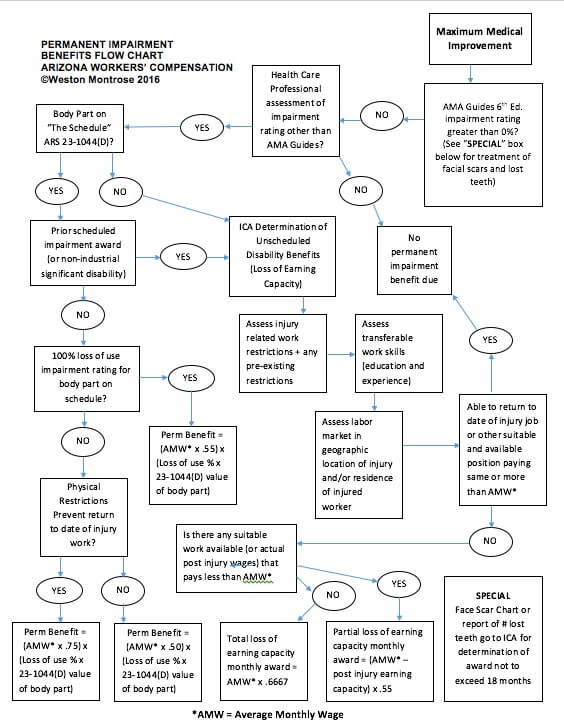Anatomy of an Arizona Workers’ Compensation Claim, Installment Two

This is part Two of a Ten part series on Anatomy of an AZ Worker’s Compensation Claim. To see part one first, CLICK HERE.
PERMANENT DISABILITY BENEFITS FLOW CHART
In Installment One I provided a broad overview flow chart for a workers’ compensation injury claim in Arizona. In this installment I made a flow chart to map an injured worker’s entitlement to permanent impairment benefits. This flow chart covers the two categories of “scheduled” and “unscheduled” impairments.
Like the flow chart in Installment One, I’m only providing basic processes for the “usual” situation. However, there are many “unusual,” unique, and novel situations that can come up. Moreover, the law is constantly clarified by court decisions or amended by the legislature. In summary, this flow chart is not intended as a substitute for a comprehensive analysis by a workers’ compensation expert. My hope is simply to give readers a road map to understand the journey, where they are in the process, and where the road will turn next.
The flow chart makes reference to A.R.S. § 23-1044(D) which establishes the “schedule” of body part values. You can use the hyperlink in this post to go directly to the full Arizona statute. For convenience here’s quick reference list of values:
Body Part Value (monthly benefit payment)
Thumb fifteen months.
First finger (index finger) nine months.
Second finger seven months.
Third finger five months.
Fourth finger (little finger) four months.
Great toe seven months.
Toe other than the great toe two and one-half months.
Major hand fifty months.
Minor hand forty months.
Major arm sixty months
Minor arm fifty months.
Foot forty months.
Leg fifty months.
Eye by enucleation thirty months.
Loss of sight w/o enucleation twenty-five months.
Loss of hearing in one ear twenty months.
Loss of hearing in both ears sixty months.
Facial Scars/Lost Teeth not to exceed 18 months
Another critical reference in the flow chart is made to the American Medical Association Guides to the Evaluation of Permanent Impairment, 6th Ed. (“AMA Guides”) A.A.C. R20-5-113(B)(1) requires physicians to “rate the percentage of impairment using the standards for the evaluation of permanent impairment as published by the most recent edition of the American Medical Association in Guides to the Evaluation of Permanent Impairment . . ..” Unfortunately there is no website available for a “do it yourself” review of The Guides since it is proprietary property of the AMA and quite expensive to purchase (I recently saw it offered on Amazon for $140). Most workers’ compensation specialists and many doctors have copies in their reference library.
Weston S. Montrose, Esq.
www.azworkcomplaw.com

Get Help Today
Call Immediately For A Free, No Obligation Consultation And Let Us Help You Put Your Life Back On Track. Let Us Help You
Regain Normalcy And Stability Again. We Want To Help You Get The Benefits You Need And Deserve!


